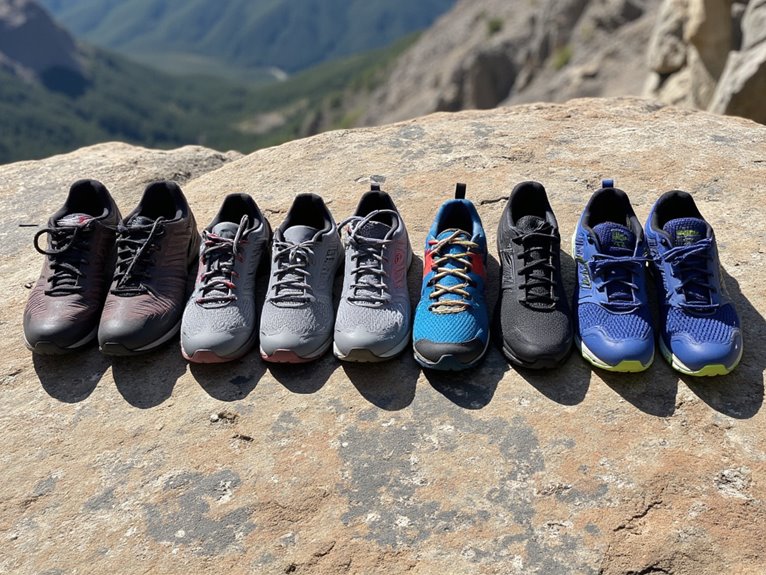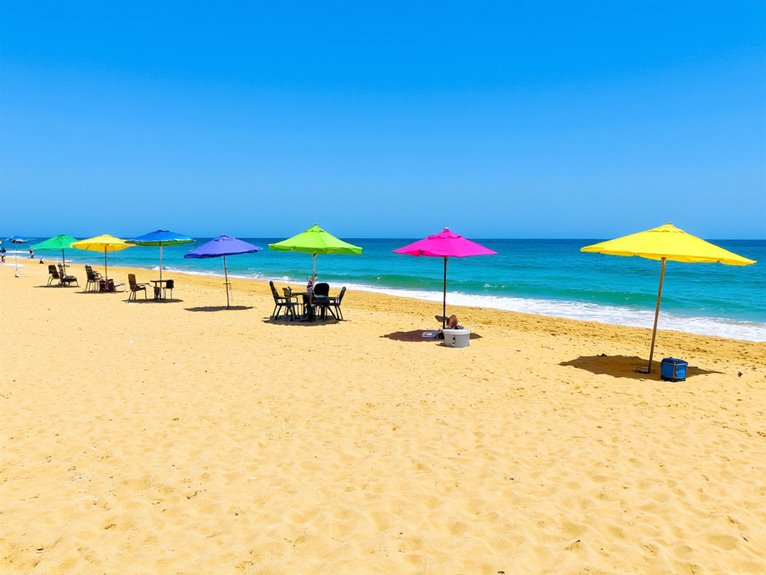How to Use a Dutch Oven While Camping?
To use a Dutch oven while camping, start by selecting the right pot for your group size and meal plans. Prepare your campsite by designating a cooking area, gathering necessary accessories, and planning meals in advance. Build a safe campfire, preheat the Dutch oven, and monitor the temperature to achieve ideal cooking conditions. Rotate the pot regularly to prevent hotspots and adjust heat input to maintain a consistent temperature. By following these essential steps, you'll be well on your way to mastering the art of Dutch oven camping. To tap the full potential of Dutch oven camping, discover more expert tips and techniques ahead.
We are supported by our audience. When you purchase through links on our site, we may earn an affiliate commission, at no extra cost for you. Learn more. Last update on 14th December 2025 / Images from Amazon Product Advertising API.
Choosing the Right Dutch Oven
Choosing the Right Dutch Oven
When selecting a Dutch oven for camping, consider the number of people you'll be cooking for, as well as the types of dishes you plan to prepare, to guarantee you choose a pot that meets your specific needs.
A larger Dutch oven may be necessary for groups, while a smaller one may be suitable for solo campers.
Consider the weight and material of the pot, as well as its thickness and heat retention capabilities.
Look for a Dutch oven with a tight-fitting lid to confirm even heat distribution.
Additionally, consider the type of camping you'll be doing; a more portable option may be necessary for backpacking trips.
Preparing for Dutch Oven Camping
With your Dutch oven selected, it's time to prepare for a successful camping trip by gathering necessary accessories and planning your meals in advance. This step is crucial to ensure a stress-free and enjoyable camping experience.
To prepare, consider the following essential items:
- Heat-resistant gloves for safe handling of the hot Dutch oven.
- Camping utensils, such as a sturdy spoon and spatula, for cooking and serving.
- Measuring cups and spoons for accurate recipe measurements.
- Recipe book or camping meal plan to guide your cooking and meal prep.
Setting Up Your Campsite Kitchen
Your campsite kitchen setup should prioritize accessibility and efficiency, positioning your Dutch oven and supporting gear in a way that streamlines meal preparation and minimizes clutter.
Designate a specific area for food preparation, keeping your Dutch oven, utensils, and ingredients within easy reach.
Consider a portable camping table or a makeshift countertop to create a stable surface for cooking and food preparation.
Organize your gear by categorizing items into cooking, cleaning, and storage zones to maintain a clutter-free environment.
A well-organized campsite kitchen will improve your overall camping experience, allowing you to focus on enjoying the outdoors while preparing delicious meals.
Building a Campfire for Cooking
When building a campfire for cooking, vital preparation is necessary to guarantee a safe and efficient cooking experience.
This involves collecting dry firewood, kindling, and tinder, as well as preparing the fire pit by clearing the area and circling it with rocks.
Gathering Fire Materials
Collecting the right fire materials is essential to building a campfire that will effectively cook your meals and provide warmth during your camping trip.
When gathering materials, focus on finding dry, flammable items that will ignite easily and burn steadily.
The essential fire materials to collect are:
- Tinder: Dry leaves, grass, or small twigs that ignite easily.
- Kindling: Small sticks and branches that will help the fire grow.
- Fuel: Larger logs that will provide sustained heat.
- Fire starter: Matches, lighters, or other tools to ignite the fire.
Remember to always follow campfire safety guidelines and regulations when building your campfire.
Preparing the Pit
With a well-stocked pile of fire materials, the next step is to prepare the pit by clearing a circular area of about three feet in diameter of any leaves, grass, or other combustible materials.
This is vital to safeguard a safe and controlled campfire.
Use a shovel or trowel to remove any debris, and if you're in a designated campsite, look for a fire ring or pit. If not, create a fire bed by scraping away the top layer of soil and exposing the mineral soil underneath.
This will help contain the fire and reduce the risk of it spreading.
Once the pit is clear, you're ready to start building your campfire.
Heating and Temperature Control
When cooking with a Dutch oven while camping, achieving proper heat distribution and temperature control is vital for successful meal preparation.
Understanding heat distribution patterns and ideal cooking temperatures is essential to prevent hotspots, undercooked areas, and uneven cooking.
Heat Distribution Patterns
Proper heat distribution is vital in Dutch oven camping, as even heat patterns can make all the difference between a perfectly cooked meal and a burnt offering.
To achieve optimal heat distribution, consider the following strategies:
Preheat the oven: Allow the Dutch oven to heat up for at least 30 minutes before cooking to ensure even heat distribution.
Use a heat diffuser: Place a heat diffuser, such as a ceramic plate or silicone mat, under the pot to distribute heat evenly.
Rotate the pot: Rotate the pot every 15-20 minutes to ensure consistent heat distribution and prevent hotspots.
Monitor temperature: Regularly check the temperature to adjust heat input and prevent overheating or underheating.
Optimal Cooking Temperatures
Achieving perfect cooking temperatures is essential in Dutch oven camping, as it directly impacts the quality of your cooked meal, and understanding the ideal temperature ranges for various dishes is necessary for successful cooking.
For example, delicate fish and poultry require lower temperatures between 325°F to 350°F (165°C to 175°C), while heartier stews and braises can withstand higher temperatures ranging from 375°F to 400°F (190°C to 200°C).
It's imperative to monitor the temperature using a thermometer, especially when cooking at high elevations where temperatures can fluctuate.
Cooking Techniques for Camping
Camping cooking techniques require creativity and adaptability, as outdoor chefs must often contend with limited equipment, variable weather conditions, and a lack of amenities.
To overcome these challenges, it's essential to develop a range of skills and strategies.
One-pot wonders: Learn to cook entire meals in a single pot to minimize cleanup and maximize efficiency.
Layering: Cook ingredients in layers to facilitate even cooking and prevent overcooking.
Temperature control: Master the art of regulating heat to achieve perfect doneness.
Make-ahead prep: Prepare ingredients ahead of time to streamline cooking and reduce campsite chaos, thereby allowing for a smoother cooking process.
Dutch Oven Recipes for Camping
Utilizing a Dutch oven while camping allows for a wide range of creative and hearty meal options, from savory stews and casseroles to sweet breads and desserts.
One popular recipe is a classic campfire lasagna, layered with ground beef, tomato sauce, and melted mozzarella cheese.
Another option is a Dutch oven peach cobbler, featuring fresh peaches, sugar, and buttery biscuit dough.
For a hearty breakfast, try a Dutch oven breakfast casserole, filled with scrambled eggs, sausage, and shredded cheese.
These recipes are easy to prepare, delicious, and can be tailored to suit your camping group's tastes and dietary needs.
With a Dutch oven, the possibilities are endless, and mealtime can become a highlight of your camping trip.
Camping Dutch Oven Safety Tips
When camping with a Dutch oven, safety should always be top of mind.
To guarantee a safe and enjoyable outdoor cooking experience, it's essential to follow proper handling and heat control techniques, as well as take necessary precautions for campsite fire safety.
Dutch Oven Handling
Proper handling of a Dutch oven is vital to guarantee a safe and enjoyable outdoor cooking experience, as it can get extremely hot and weigh upward of 20-30 pounds when fully loaded.
To ensure safe handling, follow these guidelines:
Lift with care: Use both hands to lift the Dutch oven, keeping your back straight and your body balanced.
Use oven mitts: Protect your hands from burns by wearing heat-resistant oven mitts when handling the Dutch oven.
Keep a safe distance: Maintain a safe distance from the Dutch oven when it's in use, as splatters and spills can occur.
Store properly: Store the Dutch oven in a secure, dry place when not in use to prevent accidents and damage.
Proper Heat Control
Effective heat control is paramount to achieving a successful outdoor cooking experience with a Dutch oven, as it directly impacts the quality of the dish and the overall safety of the cooking process.
To achieve ideal heat control, it's essential to monitor the temperature of your Dutch oven regularly. You can do this by using a thermometer to measure the internal temperature of the oven.
Adjust the heat source accordingly to maintain a consistent temperature. It's also vital to verify that the heat is evenly distributed by rotating the oven every 15-20 minutes.
Campsite Fire Safety
Campsite fire safety is a vital aspect of camping with a Dutch oven, as an unattended or poorly managed campfire can quickly spread and cause devastating damage to the surrounding environment.
To ensure a safe and enjoyable camping experience, it's essential to follow proper campsite fire safety guidelines.
Choose a safe location: Select a flat, dry spot away from flammable materials and overhanging branches.
Keep a fire ring or pit: Contain the fire within a designated area to prevent it from spreading.
Monitor wind conditions: Avoid having a campfire during strong winds or dry conditions.
Fully extinguish the fire: Before leaving the campsite, ensure the fire is completely out, using the 'drown, stir, and repeat' method.
Cleaning and Maintaining Your Oven
After each use, a thorough cleaning of your Dutch oven is essential to prevent the buildup of residual food particles and debris that can compromise its performance and longevity.
Begin by scraping out excess food residue with a soft-bristled brush or paper towels.
Next, wash the oven with mild soap and warm water, avoiding abrasive materials that can damage the seasoning.
Dry the oven thoroughly to prevent rust, and apply a thin layer of cooking oil to maintain the seasoning.
Regularly re-seasoning your Dutch oven can also help maintain its non-stick properties.
Troubleshooting Common Issues
Even the most well-maintained Dutch ovens can occasionally experience issues, and recognizing the signs of common problems can help you troubleshoot and resolve them quickly.
Some common issues that may arise while camping include:
Overheating: If your oven is too hot, reduce the number of coals or adjust the oven's position to maintain a safe temperature.
Undercooked food: Check that your oven is at the correct temperature and adjust cooking times accordingly.
Rust or corrosion: Regularly clean and season your oven to prevent rust and corrosion.
Lid or handle issues: Inspect your oven's lid and handle regularly, replacing them if necessary to guarantee safe and secure use, and to confirm proper function.




